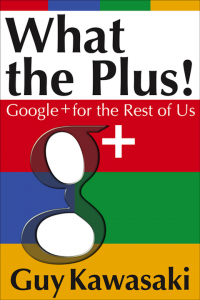Recently I had the pleasure of reading an interview of Guy Kawasaki regarding his new e-book, What the Plus! Google+ For the Rest of Us, as
In just under a year since it was rolled out, Google+ has grown to over 100 million users.
And while it hasn’t reached the stature of Facebook, Kawasaki thinks now is the time to start focusing on the new social network. As of now, it’s still the “wild west” – meaning, you can stake your claim now before the competition. With Facebook and Twitter, you have to cut through a lot of noise to reach your audience.
Another reason is search traffic. According to Guy, Google “…owns the river called search traffic” and it can “…point that river any way it wants.”
What makes Google+ desirable over Facebook and Twitter?
According to Guy, it’s the ease at which he can edit posts, the more elegant user interface as well as the quality of comments.
What kind of content does Guy put on Google+?
We’ll get into a couple of his suggestions in a minute. But one thing from the interview that really caught my attention is the content he uses. My thinking has always been to only include content we produce.
After reading this interview though, I’ve changed my mind.
Including any kind of content your readers may find interesting will keep them coming back. Guy uses a site called AllTop to find leading topics his readers may find interesting.
In fact when it comes to content, Guy suggests adopting the NPR model.
National Public Radio – both on the radio and online – provides great content 365 days a year. This content is so good that we tolerate their periodic fundraising appeals.
Content you share should provide value – information, analysis and/or assistance.
It should be valuable to the point that you earn the right to also promote your product(s) and service(s) – usually about 5% of the time. NPR for example spends the vast majority of its time providing content but there is that 5% of the time they’re promoting their services and asking for donations from listeners.
Another tip from Guy – make sure people think they’re interacting with a real person on your Google+ profile. Respond to comments quickly and be a real person behind the profile, not a “…hoity-toity brand.”
Should I focus on a business profile or a personal page?
According to Guy, it really depends on your situation. If you plan for your business to outlast you, then go for a business profile. If you’re a sole proprietorship or individual brand, then a personal page is just fine.
Regardless of which route you choose, be sure you interact directly and reassure followers that there’s a real person on the other end. Doing so will ensure they come back for more.
Guy Kawasaki was best known as being one of the original Macintosh “evangelists” back in the 1980s. Much of what drove him back then re: Macintosh is what’s driving his passion about Google+ today.
His new book is very inexpensive (…$2.99 for Kindle edition). I plan to pick up a copy and review it.
Tune back again for a quick review…
In the meantime, read Guy’s interview on Social Media Examiner for more.
Other Posts You May Be Interested In
Google and the Merging of Search and Social Media
Google + – What is it and how will it integrate into your marketing strategy?
